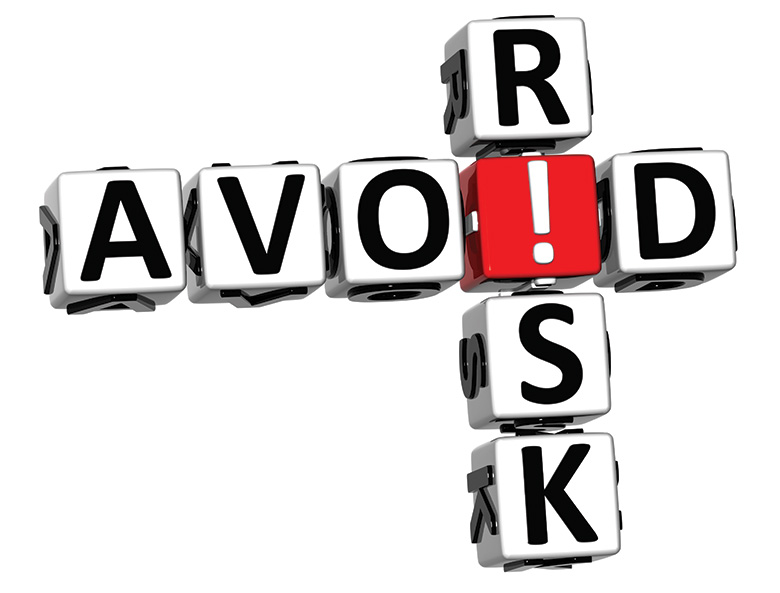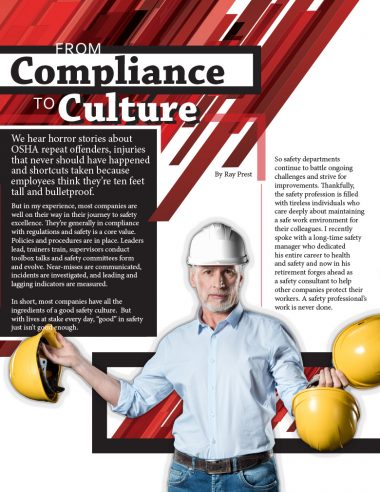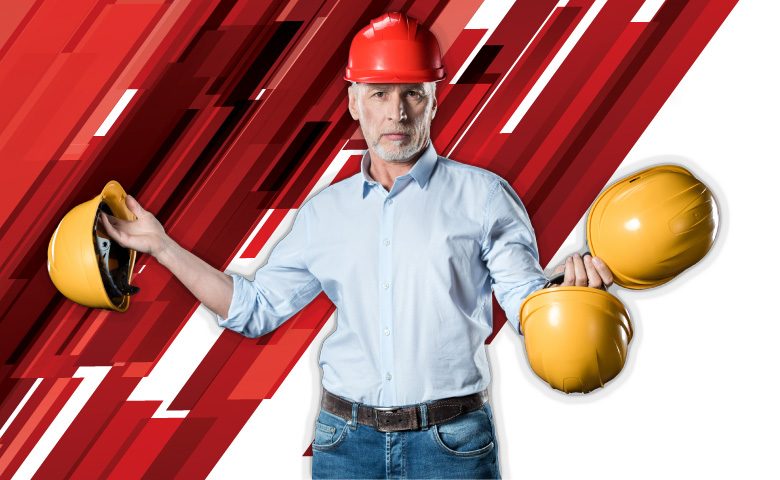This article by Ray Prest was published in the
Winter/Spring 2017 issue of Safety Decisions magazine
We hear horror stories about OSHA repeat offenders, injuries that never should have happened and shortcuts taken because employees think they’re ten feet tall and bulletproof.
But in my experience, most companies are well on their way in their journey to safety excellence. They’re generally in compliance with regulations and safety is a core value. Policies and procedures are in place. Leaders lead, trainers train, supervisors conduct toolbox talks and safety committees form and evolve. Near-misses are communicated, incidents are investigated, and leading and lagging indicators are measured.
In short, most companies have all the ingredients of a good safety culture. But with lives at stake every day, “good” in safety just isn’t good enough.
So safety departments continue to battle ongoing challenges and strive for improvements. Thankfully, the safety profession is filled with tireless individuals who care deeply about maintaining a safe work environment for their colleagues. I recently spoke with a long-time safety manager who dedicated his entire career to health and safety and now in his retirement forges ahead as a safety consultant to help other companies protect their workers. A safety professional’s work is never done.
This gentleman figured out a lot of things over the course of his career—some from formal education, some from listening to others, some from personal experience. It’s inspiring to say the least, but it pains me to see well-intentioned, hard-working safety professionals like him struggle to squeeze every last drop out of current thinking before turning to a new way of making meaningful improvements to safety at their facility.
Intuitively, we know that to move forward you have to think differently, not just work harder. With that in mind, here are some ideas that will hopefully give you a leg up if your TRIR has plateaued or you’re overwhelmed with competing safety priorities and feel like you can’t make any headway.

Compliance first
Before you even try to build a culture of safety you have to achieve an acceptable level of compliance with regulations. You can’t ask people to do more for safety if you haven’t done everything you can to control hazards, develop procedures, provide training, etc. But once you have these things in place you need to balance your focus of building safe conditions with building safer behaviors—getting people to adhere to the compliance-based system you’ve put in place.
Compliance is one of the biggest pieces in the safety puzzle. But it’s not the only piece. One of the most common places people get stuck is in treating compliance like the finish line. They keep trying to improve safety performance through better engineering, better procedures, more communication, more discipline—usually with minimal or temporary improvements. It’s what they know best.
It can take a lot of mental work to recognize that compliance is actually the starting line. There can be no meaningful safety programs without compliance. But there’s a whole world of safety improvements beyond compliance.
PPE last
Everyone knows that PPE is the last line of defense, but somehow it has become one of the biggest areas of focus for safety professionals. So much time is spent finding better, more comfortable and more stylish PPE in an effort to get people to wear it and not enough time is dedicated to understanding all of the reasons why it isn’t worn when it’s made available.
Of course you want the best PPE you can buy for employees, but even the best equipment won’t help if people aren’t wearing it consistently. And there are far more human factors that influence PPE compliance than the physical factors of the PPE itself.
It’s important to balance your effort expended to evaluating new PPE with time spent on addressing the human factors that affect how that PPE is used day in, day out. For most safety folks, this means taking additional steps to educate workers on why they need to get in the habit of wearing PPE even when nobody is watching.
Whose agenda
Employees don’t really care about OSHA fines, your TRI rate or corporate safety goals—and yet that is often what is measured and communicated to them on whiteboards, in safety meetings and company newsletters.
Instead, you need to consider what’s important to them: their family, their hobbies, their eventual retirement. Unfortunately, you can’t just say things like, “We want everyone to go home safely to their families” because it will come across as a hollow slogan if it’s not backed up by actions. You have to spend resources on creating relevant strategies, skill development and value statements that truly resonate with their lives 24/7.
You can actually improve workplace safety by turning your attention 180 degrees to off-the-job safety
Off the job to on the job
One of the biggest leaps of faith that companies need to make is protecting employees when they’re not at work. If it’s important to appeal to workers’ agendas—their personal lives—then there’s no better way to do it than by helping them bring safety with them when they leave the job site.
Yes, you can actually improve workplace safety by turning your attention 180 degrees to off-thejob safety. Help workers develop an internal awareness of safety, personal safety skills and the why’s and how’s to build relevant safety-related habits with the incentive that they will be able to apply them to their life outside of work. Then take it a step further and encourage them to teach the same lessons to their family members.
For example, if you give workers the ability to help their family members build a strong habit of PPE use at home, they will be more likely to wear their PPE at home—and at work too.
If you need help justifying time spent on 24/7 safety, look no further than the NSC’s injury stats. Employees are three times more likely to be injured outside of work and the cost of replacing skilled labor, even temporarily, can have a sizeable impact on a company’s bottom line.
If you’re not actively building a strong off-the-job injury prevention program, I can assure you that you’re missing a big opportunity for your company.
Full-circle engagement
Engaging employees in safety and getting support from leadership and supervisors are two of the most difficult challenges in safety. This is probably because neither of them can be forced. They’re both the result of building trust, establishing an environment that is motivating for employees and productive for leadership, and in demonstrating the personal and professional value of a safety program.
None of that happens overnight. But it starts by achieving all the compliance benchmarks and then asking, “Okay, what next?”
Some of the things I’ve outlined here are good places to start as you ask yourself what’s next on the agenda after compliance. If you explore and execute well in these areas, you will find that you’ve developed a strong internal culture of safety that will permeate your workgroup, facility and, with any luck, even the corporate culture.
Once you get there you will have gone full circle from creating compliant conditions to creating a culture that proactively looks out for the safety of everyone.
Ray Prest is the Director of Marketing at SafeStart, a safety company focused on human factors solutions that reduce preventable death and injuries on and off the job. A columnist for Safety Decisions since 2015, Ray’s been helping people learn about safety and training for over 20 years. Read more at safestart.com/ray.

Get the PDF version
You can download a printable PDF of the article using the button below.

